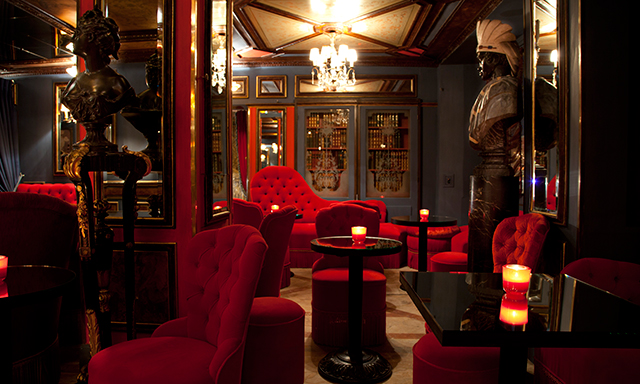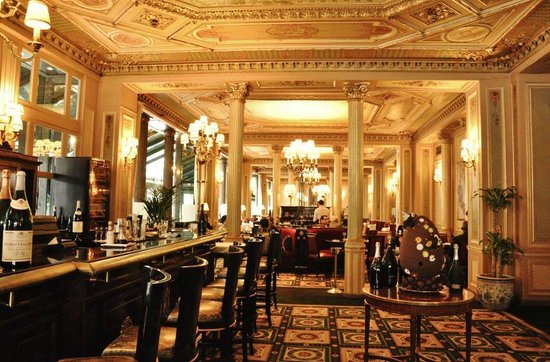Dreaming of a new "Golden Age"
- Margareth
- Jun 3, 2020
- 7 min read
Updated: Mar 28, 2023

The Belle Époque (a.k.a "Beautiful Era" or "Golden Age") was a peaceful and economic prosperity period that started in 1871 and ended with the beginning of the Great War in 1914. It was known as an age of general peace, optimism and economic growth. The non-stop discoveries and technological innovations instilled good vibrations in people of the
time so that they would think that sooner or later a solution to all the problems of humanity would have been found. It was the time when the bourgeoisie celebrated its triumph, a new phase of development and welfare that would have last until the outbreak of the Great War.
In 1895 the Lumière brothers presented their first movie "L'arroseur arrosé" in a Parisian café. It was the time of first motion pictures and new theatrical performances trials. It was the era of George Mélies, a true magician and inventor, who presented in theatres his illusionistic performances. The Excelsior dance exploded, along with the myth of progress, and was acclaimed all over Europe. During the same period, the first flight experiments began, when the Wright brothers were able to fly a rudimentary plane with a blast engine. Paid hot-air balloon trips were organised throughout the Old Continent. The Simplon tunnel was completed and the Orient Express was the first train of its category to cross Europe by rail in 1883. First passenger lines like the transatlantic Titanic offered luxury travels. The technological discoveries helped to increase the quality of life: running water and toilets, the use of the electric bulb and the introduction of the electric lift, the spread of gramophone, the first Espresso coffee machines, early sewing machines models, the first diesel cars, the first telephones etc… and World fairs were the showcases that inventors used to present their new discoveries and creations to public. The scientific discoveries helped to increase the duration of life, fighting and eradicating common diseases. It was during this era that biologists and physicians finally came to understand the germ theory of disease, and the field of bacteriology was established. Louis Pasteur developed pasteurisation and a rabies vaccine. Marie Curie worked in France, winning the Nobel Prize for Physics in 1903, and the Nobel Prize for Chemistry in 1911. Physicist Gabriel Lippmann invented integral imaging, still in use today. Art and literature rode the wave of the progress with vanguard movements like Post-mpressionism, Art Nouveau and Futurism later on. It was the time of Colonial Safaris, of the first Olympic games, of new mass media, and the advent of mass production through the assembly line.


In 1895 the Lumière brothers presented their first motion picture in history "L'arroseur arrosé" in a Parisian café.
A Trip to the Moon by Georges Méliès, 1902

The first flight experiments began during the Belle Epoque, when the Wright brothers were able to fly a rudimentary plane with a blast engine in 1903












“Beautiful Era” is the translation for Belle Epoque that best describes the happy golden age that changed people quality of life, though their cotton wool wrap was shattered by the outbreak of the First World War in 1914.
The years between the end of 19th century and the beginning of the 20th century the bourgeoisie celebrated the achievements of its hegemony with universal expositions, featuring the most striking wonders in the field technology, science, art, design and fashion.

Victorian explorers and Officers coming back from Colonial Safaris and expeditions used to conquer hordes of audience with their intriguing tales at public speaches. The investigation of the World by explorers contributed significantly to the development of modern society as we know it today. Explorers were expected to discover new lands, break records and map the world for future travellers. It was a dangerous but exhilarating opportunity for adventurers, whatever their social class, to advance scientific knowledge, acquire new mineral and agricultural resources and to make their own fortunes. Their stories just reinforced the belief of the bourgeoisie on being better, more intelligent and richer than the colonies dwellers. This only helped to instil more positivity in people of the time.

Living life with this spirit of carefree and positivity towards innovations led society to a more mundane lifestyle. People in big cities discovered the pleasure of going out just for a drink, to meet at cafes, to go to theaters and then to cinemas thanks to Lumière Brothers first motion pictures. The city streets were full of colours: elegant art nouveau style buildings, seducing advertising posters, shop windows decorated with all sorts of goods, elegant and refined department stores, chic cafés etc…
Mass entertainment was transformed by venues like the Moulin Rouge, home of the Can-Can, by new styles of performance in the theater, by shorter forms of music, and by the realism of modern writers. In Paris, restaurants such as Maxim's achieved a new splendor and cachet as places for the rich to parade. Maxim's Paris was arguably the city's most exclusive restaurant. Bohemian lifestyles gained a different glamour, pursued in the cabarets of Montmartre. This mentality and this way of dealing with life had also affected the industrial sector: decorative arts influenced not just interior design and fashion but almost every field involved in the production of goods. Every object was not just conceived to be functional but designed to be also beautiful, decorated with floral motif, curved and arabesque lines.
Elegant Art Nouveau style buildings in Paris









In 1840, this 17th century wine bar called "La Raperouse" was taken over by entrepreneur Jules Lapérouse, who wanted to cater specifically to married gentlemen who wanted to discreetly entertain the Parisian courtesans with champagne and expensive gifts. He installed lavish private rooms for them upstairs and it instantly became an institution and thrived as one of the most fashionable establishments during the Belle Epoque. Still surviving in the attic today are “chambres particuliers”, which can be visited if you ask.
The sumptuous "Café de la Paix" opened June 30, 1862, to serve the Grand-Hôtel de la Paix (named after the nearby rue de la Paix), whose name was later shortened to Grand-Hôtel. It serviced visitors of Expo exhibition in 1867.
The restaurant "Le Train Bleu" located in the hall of the Gare de Lyon railway station in Paris, was originally created for the Exposition Universelle in 1900.











Contrary to what is usually thought, it was not only the bourgeoisie who took advantage of all this technological advancement and new prosperity, but also the working class began to enjoy the economic growth thanks to new theories of the market economy. Based on such theories, manufacturers understood that if they wanted to earn more they had to produce and sell more. And in order to increase sales it was necessary that masses had more money to spend. Entrepreneurs, therefore, agreed to grant wage increases, raising per capita income in all developed countries.
Agriculture was aided both by new machines as well as artificial fertilisers and the quality and quantity of food improved. The industrial revolution made it possible the introduction of the assembly line by American entrepreneur Henry Ford in 1913 (who applied Frederick Taylor's theories for the first time). By this way, industrial efficiency was improved. Industry began producing for the first time large quantities of goods in series, differentiating itself from craftsmanship. Consumer goods such as clothing, footwear, furniture, household utensils, which were first handcrafted and sold by small retailers began to be offered by an ever-widening commercial network. The number of big department stores increased, new forms of payment such as instalments were created making expensive products more affordable. In support to this massive sales strategy, advertising posters were beginning to fill the walls of Paris - the capital and symbol of the Belle Epoque - and the pages of newspapers.
“Affiche Artistique” was the term that the French used to describe a poster that contained artistic expression. The art was so impressive to the public, people began to collect the posters as soon as they went up, which is why they are so scarce today. Artists such as Alphonse Mucha, Henri de Toulouse-Lautrec, Jules Chéret, Théophile-Alexandre Steinlen, Alfred Choubrac, contributed to the creative body of work that became what some called “a free museum for the masses”. The craze for collecting these examples of modern art was even given the name, "affichomanie", meaning “artistic poster mania”. Collectors today pay hundreds, if not thousands for original prints of these rare posters.






















All this confidence in scientific progress and technology, the awareness of finally being able to create a prosperous future for everyone, being able to reduce social imbalances (thanks to the abundance of resources and raw materials from India and Africa) led to the great success of the Universal Exposition of Paris in 1900. Paris was the symbol of Belle Epoque at the time and it was decided to use the universal exhibition as a showcase to present the new inventions and the resources coming from the colonies. People came from all over to visit this huge fair. Among the inventions that visitors could admire there was: the moving walkway, the first escalator, the first subway, the first electric lamps on the city streets, the giant telescope, the Michelin Guide, the cinema, the first electric car and many more …
Distances were dramatically reduced thanks to new modern rails (which expanded hugely) and trains like the Orient Express in Europe and the Pullman Car in the US). Subway lines made their first appearance in big cities at the beginning of 20th Century and many existing automotive companies started their activity during the Belle Epoque: the RENAULT in France, the MERCEDES in Germany, the ROSS ROYCE in England and the FIAT (Fabbrica Italiana Automobili Torino) in Italy.


The “Golden Age” was a period of rapid economic growth also in the United States, an era when anyone was a potential Andrew Carnegie, and Americans who achieved wealth celebrated it as never before. Chicago experienced even greater growth, with a staggering ten-fold increase in population between 1870 and 1900.

The Belle Époque was an era of progress and prosperity, the era of cultural exuberance, the era of Art Nouveau extravaganza ...
The architectural heritage of the Belle Epoque style, aka fin de siècle style, is still much appreciated around the world as a distinctive and unique elegant one. Walking around the historic old districts of big cities, we can enjoy some outstanding examples of this amazing style. And if we are lucky enough, we will be able to admire the ornately decorated façades with their bow-windows, corbels and magnificent balconies with balustrades or wrought ironwork, that still retain their original colour. What a sight for sore eyes!
























Commentaires